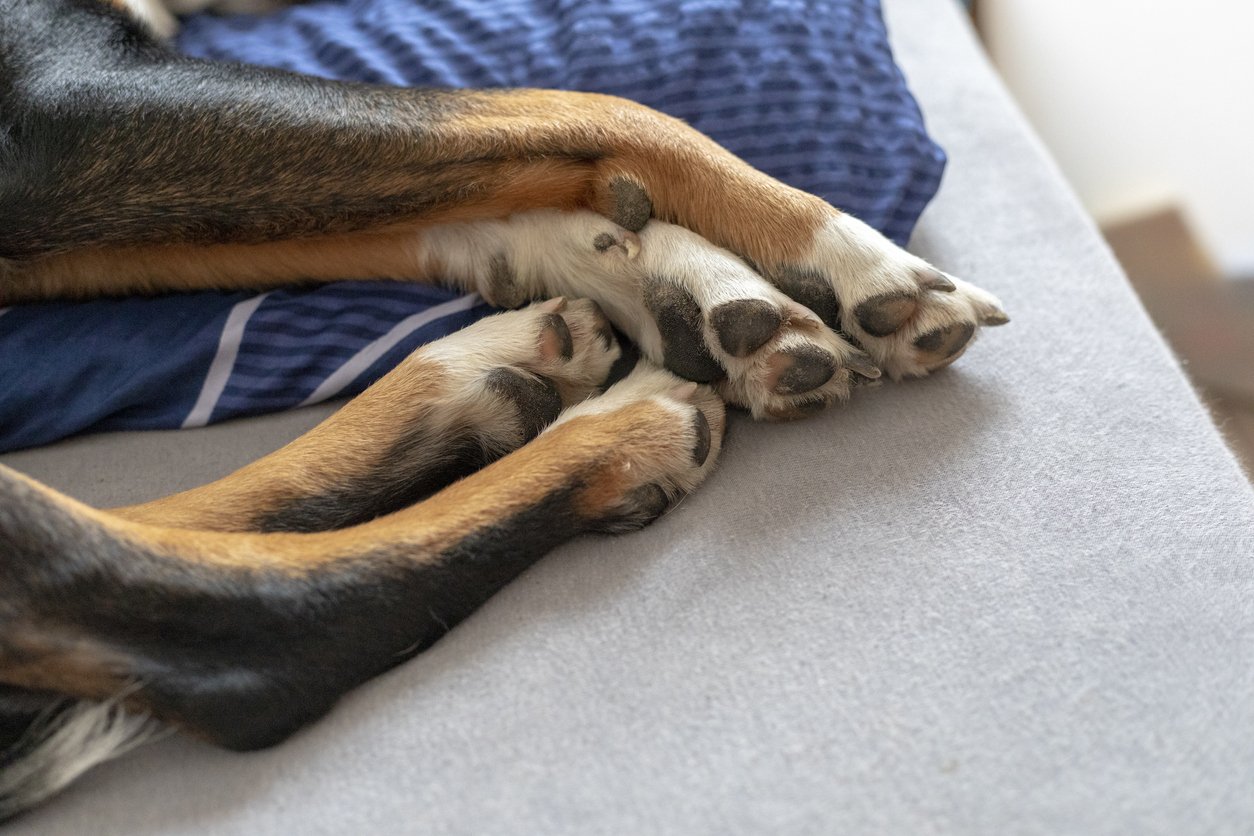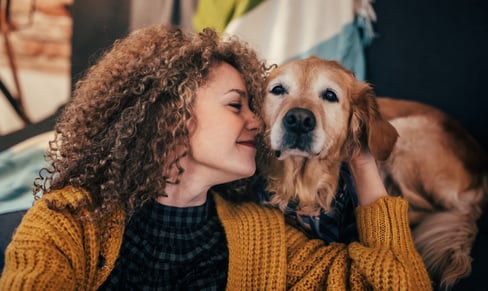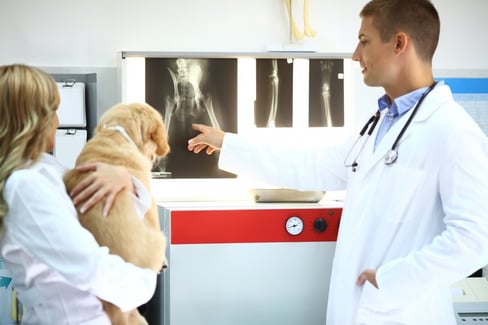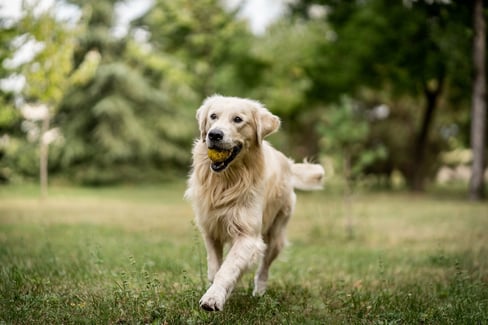Table of Contents
It’s important to build your dog’s strength from the ground up – their legs being the ground in this case.
Dog legs are the powerhouse of your pup’s strength. Without their strength, your dog can’t run, jump, walk, or play. And nothing is more debilitating than a dog legs injury.
One injury to dog hind legs or front legs, and your poor pup will be out of commission for a while, which is just no fun to you or your dog!
Thankfully, many dog legs’ that are injured can recover well if addressed properly, and you can even prevent many of the injuries common to dog legs – you just have to know-how. This is why we’re sharing answers to common questions about dog legs health issues in this post, so you can be paw-pared in case!
Overview of Dog Legs Health
A dog’s legs are pretty important. They hold your dog up, allow him to stand, and move. That being said, most dog owners don’t actually know much about the anatomy of their dog’s legs and how they work, as well as the structures that work together to make motion possible.
So before we go any further, let’s talk about some of the key parts that make up dog legs.
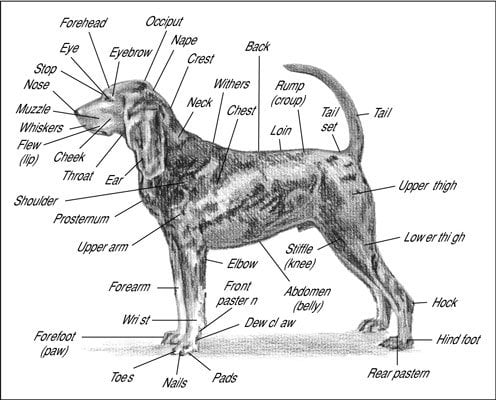
Let’s start with the basics. There are two types of dog legs:
- Forelegs (the front two legs)
- Hind legs (the back two legs)
You’d think that the forelegs and hind legs of a dog would be similar, but they’re more like having arms and legs rather than four legs. The forelegs are most similar to human arms, and the hind legs are most similar to human legs. Within each of these limbs, there are important secondary “parts” such as the wrists and knees, just like humans, too.
In order to keep things straight for the rest of this post, we wanted to share a handy glossary of dog legs terms and parts so we’re all on the same page as we discuss issues with each. Consult the table below for a quick reference guide to dog legs.
| Dog Legs Part | Description |
| Elbow | Located just below the chest, on the back of the foreleg. It is the first joint in a dog’s leg. |
| Forearm | The bone that runs from the elbow to the end of the foreleg. It is composed of the radius and the ulna. |
| Wrist | Located at the end of the foreleg below the elbow. |
| Pasterns | In the same way that you have bones in your hands and feet, dogs have them in their forelimbs and hindlimbs. |
| Knee | Also known as the stifle. Located on the front of the hind leg, this joint lines up with the abdomen. |
| Hock | Joint at the back of a dog’s legs that makes a sharp angle. Comparable to the ankle in humans. |
| Hip | Located where the femur meets the pelvis is the ball and socket hip joint. The “ball” (femoral head) should fit tightly into the “socket” (acetabulum). |
You can see where each of these parts of dog legs are located in the diagram above. Keep them in mind as we move through each of the sections below.
Common Dog Hind Legs Issues
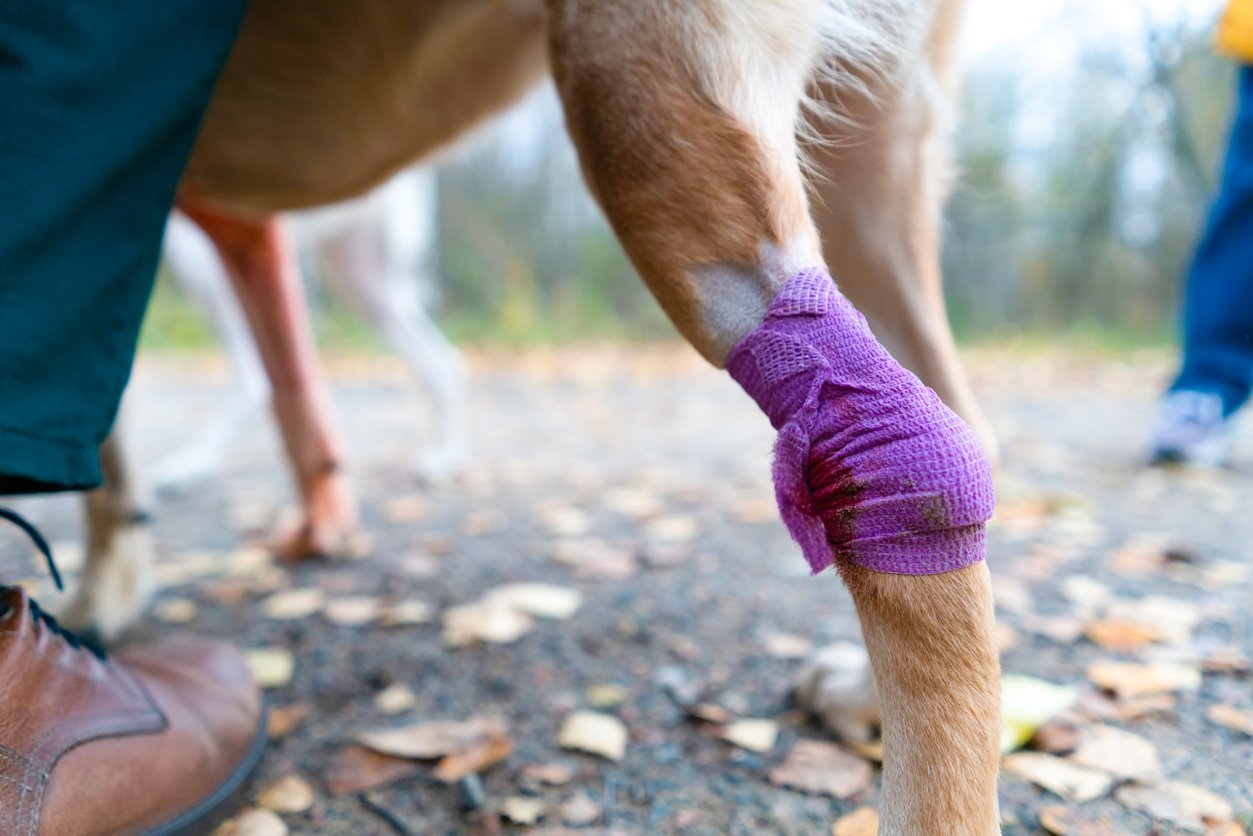
Your hind dog legs are the place where your dog takes off from a jump and pushes forward as they chase the ball.
Dog hind legs have three major joints:
- Stifle (knee)
- Hock (ankle)
- Hip
Each joint can become painfully affected by injuries and degenerative joint conditions like arthritis.
Common signs owners spot when it comes to injured back legs are:
- Your dog having trouble getting up (hind legs)
- Your dog can’t walk on back legs
- Your dog can’t stand on hind legs
These are all reasons to pay close attention to your dog and call the vet if you suspect something’s out of the ordinary.
Dog Having Trouble Getting Up Hind Legs: Arthritis
“My dog can’t walk on his back legs!”
It’s a scary sight to see when your pup can’t move like they usually do. The first common problem owners note when talking about dog legs injuries is when they see their dog having trouble getting up, and specifically, their dog hind legs seem to be the reason why they can’t get up.
This is often one of the first signs of dog arthritis.
Arthritis occurs when cartilage wears away from the joint faster than the body can replace it, causing chronic inflammation. In the absence of cartilage, the bones and joints rub against each other, causing pain and swelling. This is common in dog legs as they experience a lot of wear and tear over time.
Preventative treatment can limit cartilage deterioration before it’s too late. Providing a balanced diet and exercising regularly keeps your dog’s weight down, and the pressure off dog joint health. This can be helpful in the prevention of dog legs’ pain.
But when your pup is experiencing dog legs pain due to arthritis, symptoms appear such as:
- Inflammation
- Pain
- Swelling
- Stiffness
- Lack of mobility
Painkillers may seem like a good option for dog legs discomfort, but they can have unknown or risky side effects. Plus you can only get them through a prescription from your vet. Home modifications for dog legs’ pain, such as softer beds and ramps, only go so far to help, too.
Supplementing your dog’s diet with joint supplements is a less risky and more beneficial alternative.
Joint supplements make dogs’ legs healthier and stronger with the help of the following ingredients:
- Glucosamine
- Chondroitin
- MSM
The anti-inflammatory properties of these ingredients can relieve arthritis symptoms without the complications and potential side effects associated with painkillers.
My Dog Can’t Walk On Back Legs: Hip Dysplasia
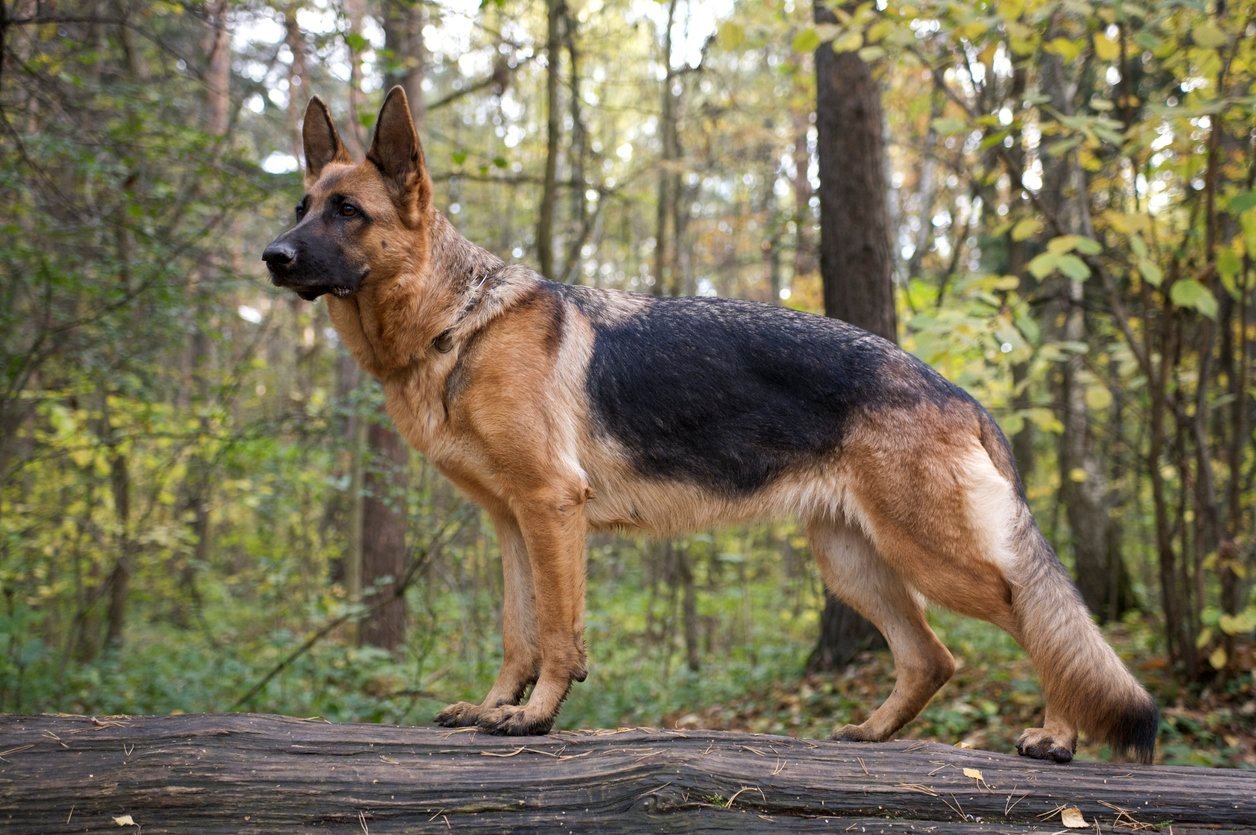
If you’re wondering why can’t my dog walk on his back legs – it might be hip dysplasia. Hip dysplasia is a degenerative dog hind legs disease that is also hereditary, which means it will most likely affect future generations if they are bred.
This dog hind legs condition can onset at an early age, in some breeds as young as four months. The femoral head of a dog should fit tightly into the sockets of its hips. When hip dysplasia is present, the femoral head cannot fit properly into the socket. Severe hip dysplasia can lead to partial dislocations and bone spurs on the rims of the sockets and the femoral heads themselves.
Some common signs that a dog hind leg injury could be hip dysplasia include:
- Bunny hopping
- Difficulty climbing stairs
- Limited range of motion
- Hindquarter muscle loss
- Dog can’t get up back legs
Hip dysplasia is a type of genetic dog hind legs injury, it cannot be prevented 100% – only by spaying and neutering affected dogs so they don’t reproduce can hip dysplasia be prevented.
If your dog is a breed such as a German Shepherd or Golden Retriever that is more prone to hip dysplasia, you should focus on:
- Maintaining a healthy weight
- Avoiding strenuous, inconsistent exercise, especially for puppies
- Supplementing their diet with glucosamine for dogs
- Completing screening for hip dysplasia between 4 months and 23 months old
- Avoiding injury and trauma to the hip joint
As far as treatment is concerned when your dog can’t walk on hind legs, hip dysplasia may require extensive surgery, including a hip replacement, which will take time to heal properly, and may need to be done on both hips. A combination of physiotherapy, a healthy diet, and supplements may help reduce the severity and overall discomfort of hip dysplasia in dogs.
Dog Can’t Stand On Hind Legs: Broken Leg
When a dog can’t stand on hind legs, you know something is seriously wrong.
Sometimes, a dog unable to walk on back legs is experiencing a broken leg. Another name for a broken bone is a fracture. Your canine can fracture their tibia, fibula, or femur bones in dog hind legs. Dogs can accidentally fracture a leg bone during times of exercise or play, or when an accident such as a run-in with a vehicle. Not all events lead to broken bones, though. Dog legs can also be dislocated or may have smaller fractures known as hairline fractures, which are small cracks in the bone.
The best way to prevent broken dog legs is to:
- Avoid traffic and other dangerous scenarios while off-leash
- Skip uneven, hilly territory where trips and slips are common
- Exercise your dog consistently and in short periods
- Be careful when playing with high-bouncing balls and other toys
- Use caution when your dog plays with their canine friends
If you suspect a broken leg, get your dog to the vet for an assessment. Breaks are painful and can happen instantaneously. Often, care from a professional is the only way to fix broken bones as it is such a serious injury.
Common Dog Front Legs Issues
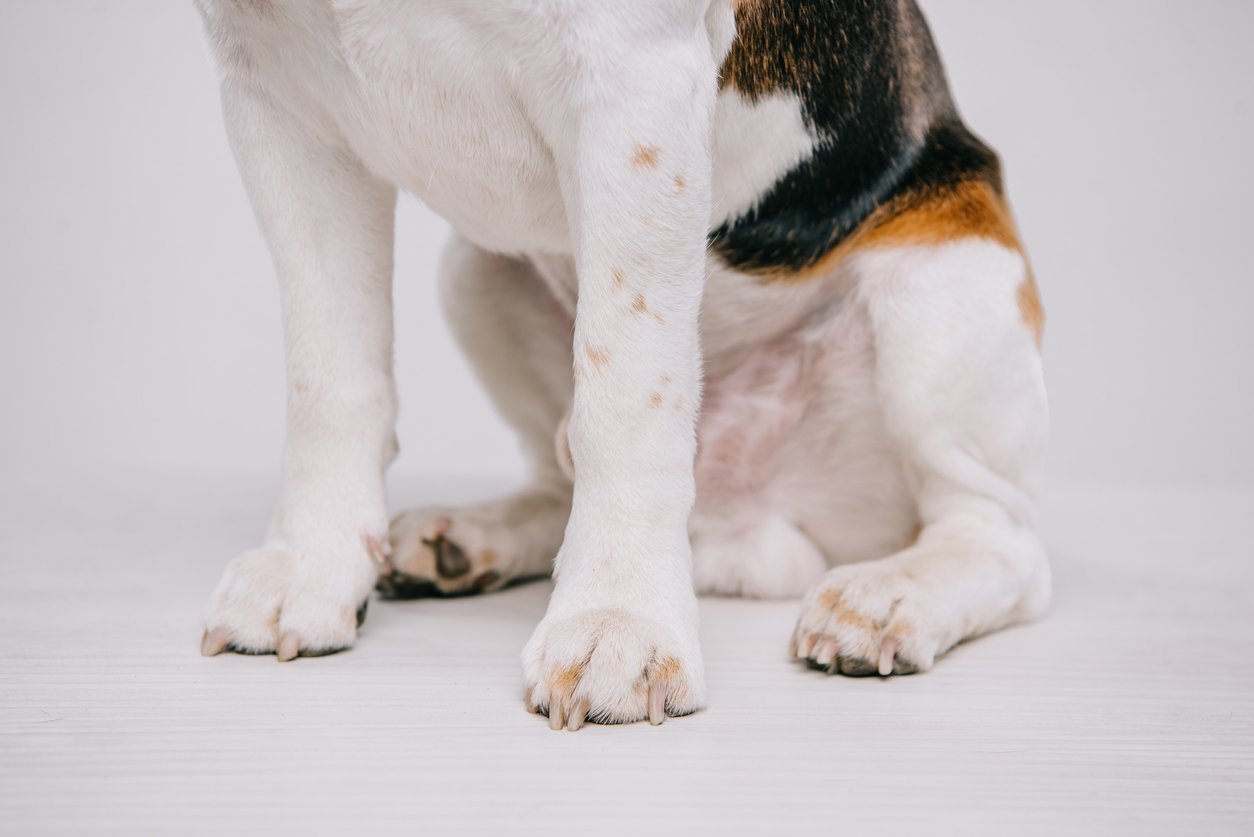
It’s time to consider the other dog legs – the forelegs. These legs are often your dog’s landing gear when they jump or leap from a height. Unfortunately, that means they may be more at risk for common injuries like sprains and strains.
Front dog legs feature several important joints and parts:
- Elbow
- Wrist
- Knee
- Paws and feet
Like dog hind legs, front dog legs can also experience arthritis and joint pain, as well as trauma from injuries.
When a foreleg gives out, it could be a sign of other front dog legs injuries:
- Sprained wrist
- Elbow dysplasia
- Paw injury
There are a number of reasons to watch your dog closely and consult your veterinarian if something seems amiss.
Dog Front Legs Give Out: Sprained Wrist
Due to its location on the foreleg below the elbow, the wrist is particularly vulnerable to injury. Strains are most common in the hind legs of dogs, while sprains more commonly affect the ligaments that connect the bones in the forelegs, especially in the wrist and knee.
Often, dogs who love jumping down from decks, cars, beds, or couches can land the wrong way and sprain their wrist. Other times, vigorous exercise can be the culprit, thanks to uneven ground or a frisbee catch that has gone awry.
Front dog legs experiencing a wrist injury may look like:
- Swelling or irritation around the wrist area
- Lame dog symptoms (slow, sedentary, limping)
- Stiffness when getting up
- Dog front legs give out
- Favouring one leg
If you’re worried that your sweet furball has hurt its front dog legs and has a sprained wrist, make an appointment with your veterinarian right away to rule out more serious conditions
If the wrist injury is severe, the veterinarian might recommend surgery. Many dog parents consider braces or dog legs splints as well combined with several weeks of rest when surgery isn’t an option.
Anti-inflammatory medicines can greatly reduce pain, but their side effects may not be desirable to dogs or owners in the long term.
Instead, a joint supplement like TRI-ACTA H.A. can help your pup recover from front dog legs injuries in no time as well as build strong joints from the inside. This helps fight both injury and degenerative joint conditions. With the power of hyaluronic acid added to our regular strength formula, synovial fluid improves and they can become more mobile again. Your dog gets this alongside the pain and inflammation relief, too. That way, your pal will be back to their old selves before you both know it.
TRI-ACTA H.A. for Pets
Our maximum strength formula is optimally designed to accelerate the formation of cartilage, minimize inflammation, expedite the healing process, and improve joint conditions.

Front Dog Legs Issue: Elbow Dysplasia
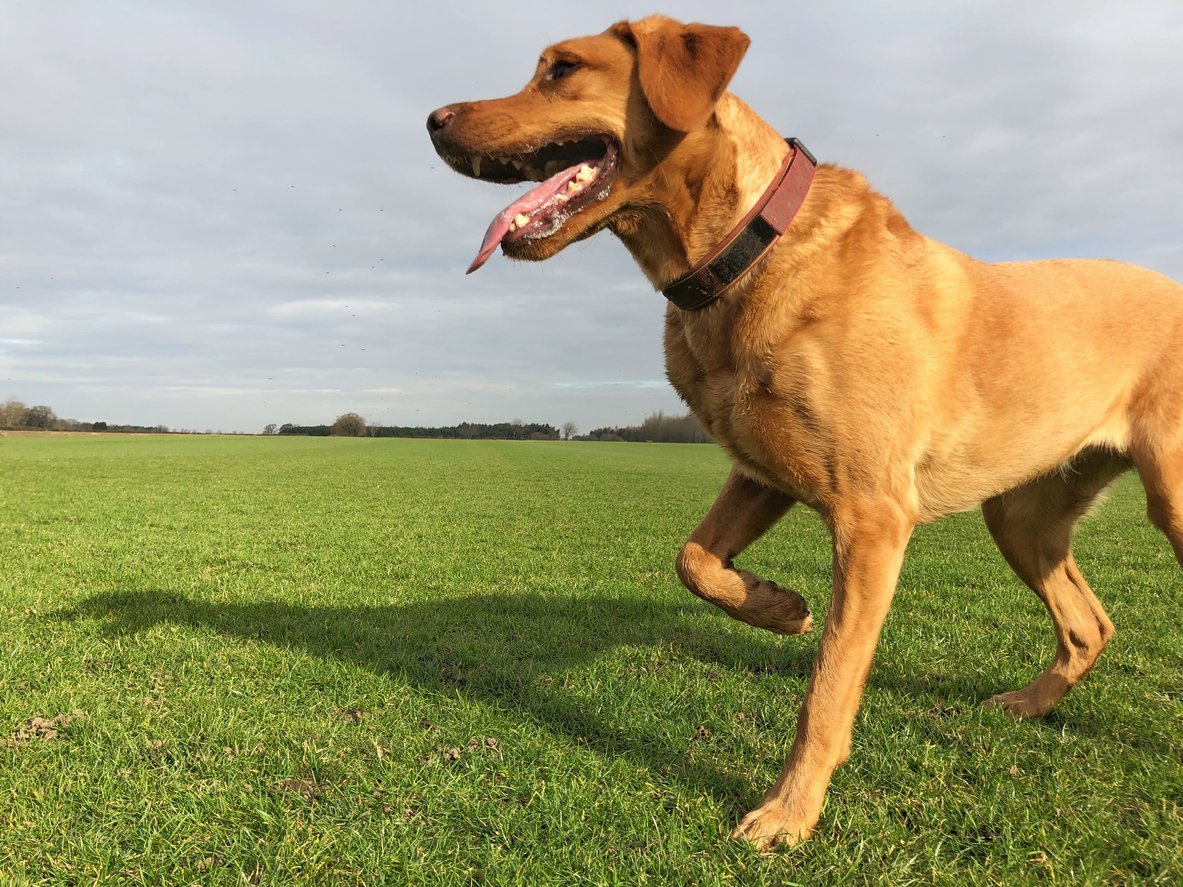
Dog elbow dysplasia is a general term for the abnormal development of elbow joints in dog legs.
Dog legs elbow dysplasia is a condition that most often occurs in large breeds that grow too quickly in puppyhood, causing abnormal:
- Bone growth
- Cartilage development
- Joint stress
- Conformity of joints
Dog elbow dysplasia seriously affects your canine companion’s quality of life. It’s also one of the most common causes of osteoarthritis in dogs’ elbows, so there are plenty of management and treatment options, but it is not fully preventable.
There are a few things you can keep in mind to reduce the likelihood of experiencing this dog legs condition, as outlined in the table below.
| Dog Legs Elbow Dysplasia Prevention | Description |
| Breeder Selection | To avoid pups who are genetically predisposed to elbow dysplasia, select a breeder who complies with screening programs and guidelines from OFA and IEWG (International Elbow Working Group). |
| Balance Diet | Avoid excessive nutrient intake in puppies to make sure they grow at an even pace, and for adult dogs, keep weight low to reduce joint stress. |
| Joint Supplements | Joint supplements ensure that their joints form correctly and their cartilage is healthy during growth and maturation. It also supports senior pups experiencing pain from symptoms or post-operatively with anti-inflammatory and pain-reducing properties. |
When it comes to treating elbow dysplasia, implementing various rehabilitation techniques such as braces and physical therapy alongside joint supplementation can help reduce the pain, inflammation, and mobility challenges associated with the condition. When your dog is suffering extreme pain and the most severe symptoms, surgery may be the best option. Always consult your vet for advice if you are unsure what may be best for your pup.
Front Dog Legs Issue: Paw Pad Injury
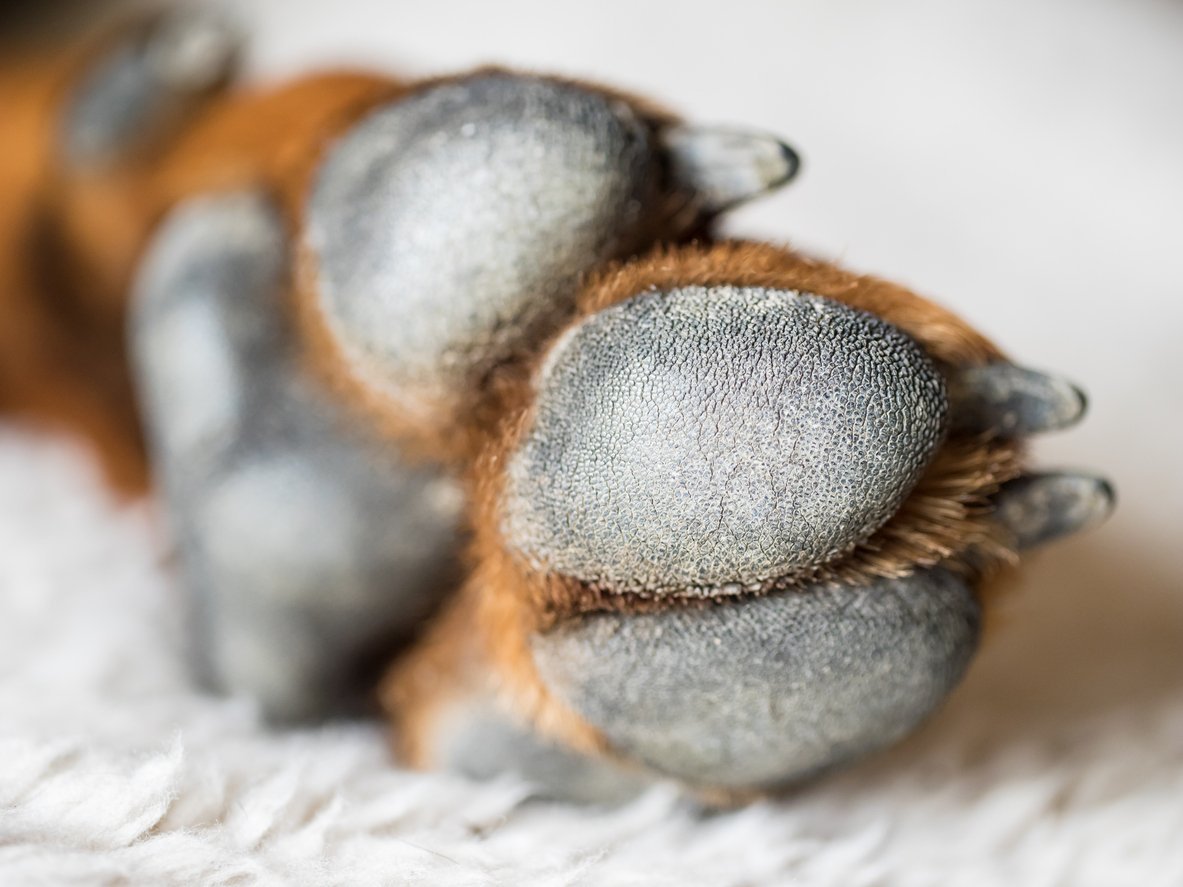
You’re walking along on the sidewalk, or enjoying a romp in the woods and suddenly your dog yelps out in pain and begins limping. Often, this is what it looks like when a front dog legs injury to the paw pad appears.
Common causes a dog injures or lacerates their paw pads or front dog legs include:
- Cuts and scrapes caused by sharp objects (glass, rocks, trash)
- Paw pads cracked due to dryness
- Stings or bites from insects
- Getting frostbite
- Punctures in the paw (commonly with a stick)
- Burns from heat or chemicals
When you spot blood, debris in your pup’s paw, or sudden limping, it’s time to inspect their dog legs and paws for injury and apply first aid.
The best course of action for dog legs first aid should include:
- Cleaning the wound with cool water
- Removing debris (if any) using tweezers or fingers very carefully if the debris is surface-level
- Applying light pressure to stop bleeding
- Applying a bandage and cleaning the wound regularly
- Visiting the vet if the bleeding doesn’t stop or the wound is deep
Once you have the bleeding stopped, your dog will need to rest and avoid reopening the cut. Sometimes, a visit to the vet is required for a more thorough inspection and stitches if the wound is severe.
Using an extra-strength joint supplement like TRI-ACTA H.A. after the injury can help dog legs heal faster. And, thanks to the inclusion of MSM, it reduces pain and inflammation in their joints and soft tissues. This will help make life a little easier and more comfortable for your dog while they recover.
TRI-ACTA H.A. for Pets
Our maximum strength formula is optimally designed to accelerate the formation of cartilage, minimize inflammation, expedite the healing process, and improve joint conditions.

Dog Knees Issues
Part of your dog hind legs, dog knees are susceptible to injuries, just like our own knees are. This joint has the important job of hinging and allowing your dog to move. Without them, your dog won’t be able to get very far.
The knee has several important bones that make up its structure in dog legs:
- Femur
- Tibia
- Fibula
- Patella
Each structure is connected together with ligaments and tendons to make motion paw-ssible for your pup. When one or more parts of these structures are injured or break down due to degenerative joint conditions, your dog can experience knee pain.
Luxating Patellas
A luxating patella is what happens when one or more dog legs’ knees experience the patella dislocating, or sliding out, of the femoral groove when your dog moves. The knee can deviate either laterally or medially (inside or outside). Sadly, luxating patellas are recurring and can be very uncomfortable for dogs.
Due to a genetic predisposition, some dogs are more likely to develop luxating patellas than others, including toy breeds, miniature terriers, or French poodles. Regardless, really any dog can experience luxating patellas. The good news is you can prevent it from becoming a painful issue for your dog in most cases.
Maintaining the right weight for your dog’s breed is one of the easiest ways to prevent a luxating patella. One way to keep your dog’s body weight down and the stress off of their knees is to feed them a balanced diet and exercise regularly. A healthy diet should include essential fatty acids and glucosamine for dogs to keep joints lubricated and promote cartilage development and maintenance.
It’s not always possible to protect your dog from patellar luxation. Sometimes, your dog’s genetics are going to determine the outcome, as hard as you may try to prevent it.
In that case, you want to look for dog legs symptoms like:
- Limping
- Lethargy
- Excessive licking
- Favouring one leg over another
If you spot those signs, it’s time to call the vet. They can help you determine the best course of action, whether that is surgery or non-surgical management. Dogs that experience recurrent lameness or other injuries secondary to the luxating patella may need surgery. Other times, where the case is not as severe, luxating patellas can be managed through bracing, physical therapy, and the inclusion of a joint supplement.
The addition of joint supplements to help luxating patellas in dogs can support the formation of collagen and maintain bone and joint health, as well as promote cartilage growth in the kneecaps. Dog legs can greatly benefit from two types of glucosamine and chondroitin, especially when it comes to luxating patellas, osteoarthritis, and discomfort associated with injuries and ageing.
CCL Rupture
The ACL on a dog is an important ligament in their knee joint, housing two critical ligaments: the cranial and caudal cruciate ligaments (CCLs). Cruciate ligaments are named so because they form a cross over the femur and tibia. This fibrous band of tissue in dog legs connects the bones above and below the knee joint to allow the joint to work as a hinge.
Dog torn ACLs affect dogs of every age and size, with obese and large-breed dogs having a higher risk.
A higher incidence also occurs in specific breeds, including:
- Labrador retrievers
- Golden retrievers
- German shepherds
- Rottweilers
- Pitbulls
Cranial cruciate ligament rupture is intensely painful, and affected dogs often cry out and experience an array of symptoms.
Dog legs that have a ruptured ACL will usually look like:
- Unable to rise from a seated position
- Dog limping
- Muscle atrophy
- Swelling around the shins
- Unable to bear weight on the affected limb
- Lack of movement and mobility
Call your vet immediately if you spot any of the signs of a dog with an ACL injury as this is a serious and painful injury, and you wouldn’t want your pup to suffer any more than they have to.
Typically, CCL dog leg injuries are treated non-surgically in dogs weighing less than 30 pounds. Rest and anti-inflammatory medications are prescribed for six weeks to two months, followed by a gentle exercise and weight management program. However, a lack of a healthy dog ACL will result in bone spurs, arthritis, and a decreased range of motion, especially in larger dogs.
CCL surgery for dogs includes a number of different techniques that aim to provide stability to the joint. Depending on the procedure used, it may take two to three weeks before your dog is able to bear weight on the injured leg. Adding a joint supplement like Integricare’s TRI-ACTA or TRI-ACTA H.A. to their diet before and after surgery is a great way to expedite the healing process and reduce the painful symptoms of these dog legs injuries along the way.
Conclusion
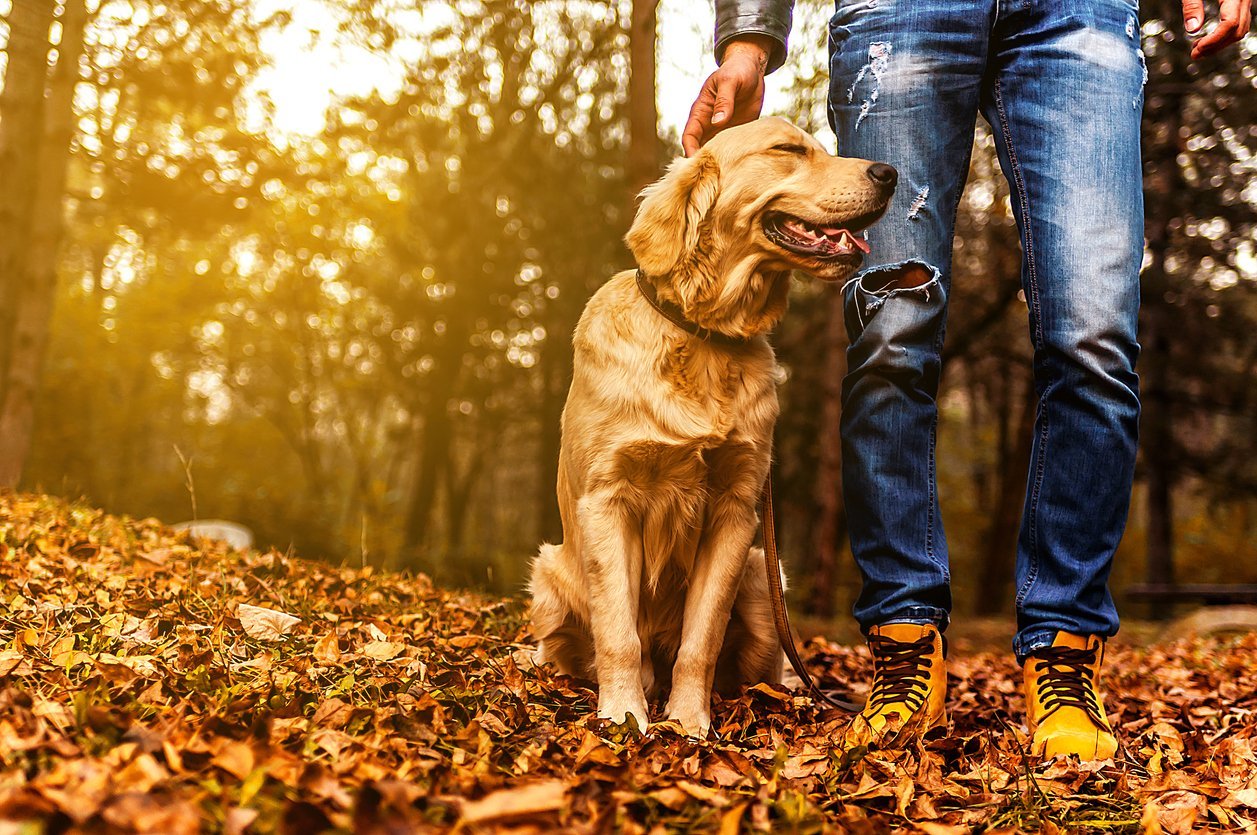
When your old dog can’t walk on its back legs or their dog front legs give out, you know it’s time to change something in its diet and lifestyle.
Better prepare your dog legs for an injury by adding a joint supplement like Integricare’s TRI-ACTA for pets to your daily routine. It helps reduce pain, and inflammation, and helps restore and preserve joint cartilage. That way they can spend less time recovering from injury, and more time doing what they love.
Get more tips and advice on animal wellness and health on our blog, and find out where to buy TRI-ACTA so you can start preventing painful injuries to dog legs.
TRI-ACTA for Pets
A proactive approach for developing and younger adult pets to maintain optimal joint health mobility, minimize inflammation and fend off age-related ailments.
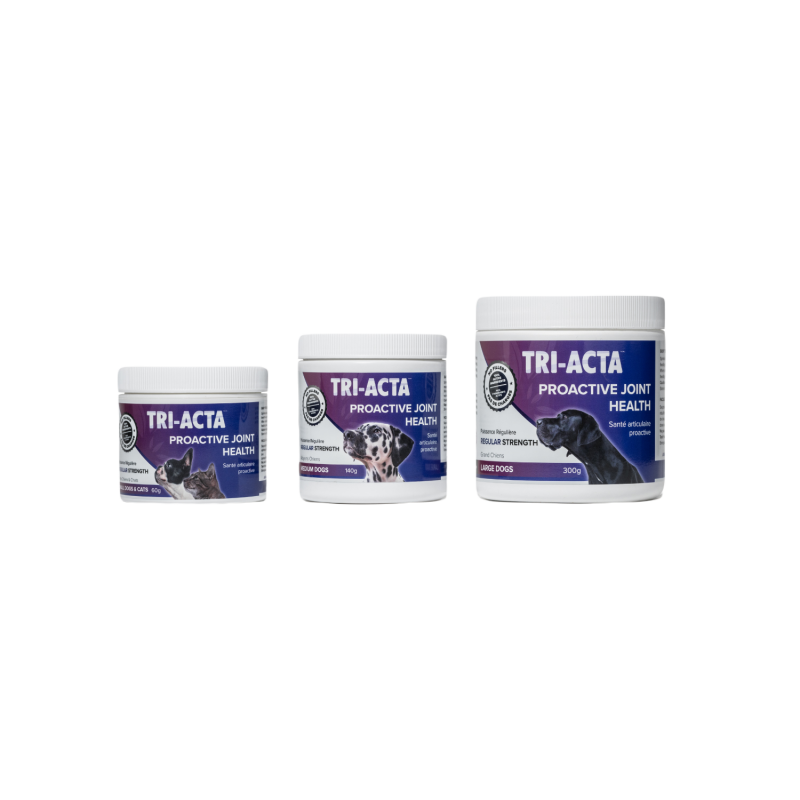
Newsletter Signup
Subscribe to our newsletter to receive the latest news and exclusive offers.
.jpg?height=2000&name=Cliick_Integricare-DISPLAY-REVISEDV2%20(1).jpg)
Proactive & Therapeutic Joint Supplements
When given daily, Integricare joint supplements recover bone and joint injuries faster and help prevent mobility injuries from happening in the first place.

